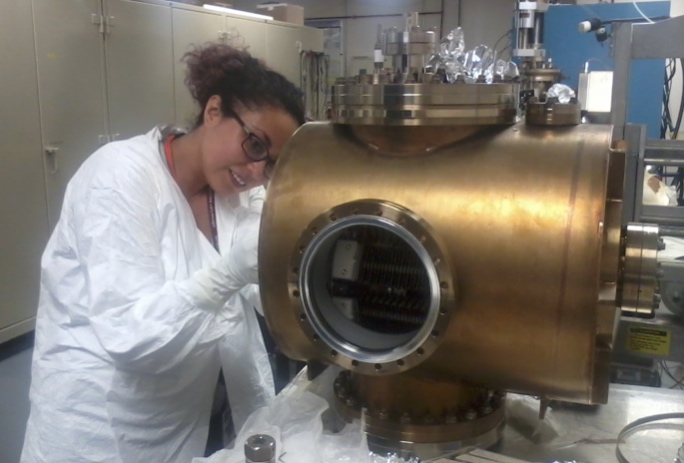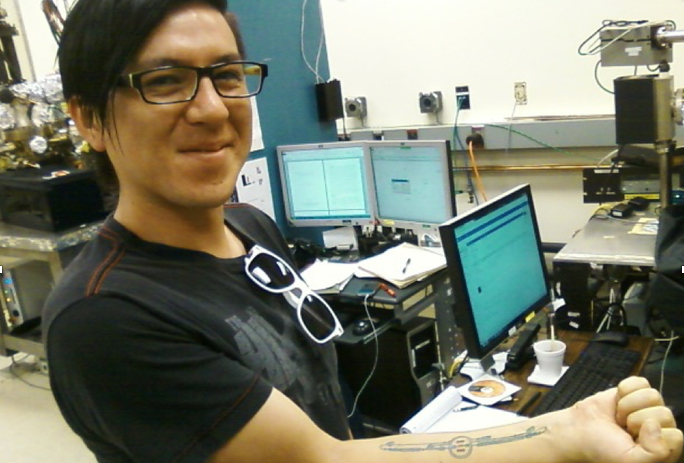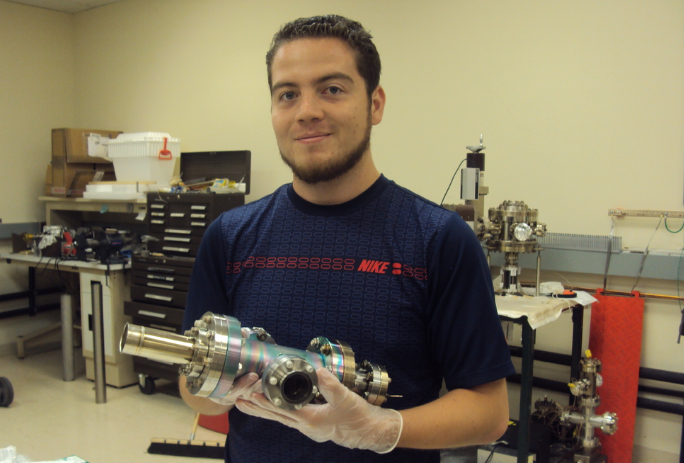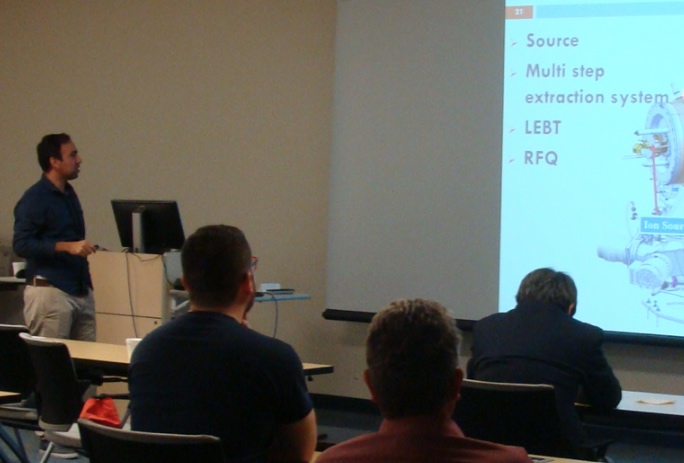For a decade now, Carlos Hernandez-Garcia spearheaded a program that brings undergraduate students from Mexico to Jefferson Lab to study accelerator physics
You never know how many lives a lunch could change.
Ten years ago at the Department of Energy’s Thomas Jefferson National Accelerator Facility, Carlos Hernandez-Garcia, now a senior scientist at Jefferson Lab, was chatting over lunch with Anthony Thomas, Jefferson Lab’s chief scientist at the time. That conversation eventually led to the creation of a program that has brought undergraduate students from Mexico to Jefferson Lab to work on accelerator physics projects for the last decade.
During that fateful lunch, Thomas suggested that Hernandez-Garcia, who is originally from Mexico, mentor a student visiting Jefferson Lab from Mexico for the summer through a theory research stay abroad program. Hernandez-Garcia agreed.
Hernandez-Garcia mentored Cristhian Valerio as he worked on a project that involved upgrading electron guns, which are the source of electrons for electron beams in particle accelerators.
“We had such success with Cristhian,” Hernandez-Garcia said. “We don’t have accelerators in Mexico, so it was an eye-opening experience for him to come here and see the machine and participate in meetings with scientists.”
Valerio, now a researcher and professor at the University of Sinaloa in Mexico, said that the experience determined the trajectory of his career: “It was decisive, because I changed the focus of my career to accelerator physics, which is what I do now.”
After that summer, Valerio invited Hernandez-Garcia to speak at the annual meeting of the Division of Particles and Fields of the Mexican Physical Society in November 2010.
“When I presented, the scientists were very interested,” said Hernandez-Garcia. “So interested, they asked if they could send me another student next summer.”
Again, Hernandez-Garcia agreed. This time, he had to find funding. Initially, he received financial support from Jefferson Lab’s Accelerator Division. But since 2014, the program, now officially called the Accelerator Physics Education Outreach with Mexican Universities program, has been supported by grants from Jefferson Science Associates, LLC, through its Initiatives Fund program. The JSA Initiatives Fund Program supports projects, initiatives and activities that further the scientific outreach, and promote the science, education and technology missions of Jefferson Lab and benefit the lab user community.
“It’s really thanks to the support of JSA that this program can still exist, because finding funding is extremely difficult,” Hernandez-Garcia said. A total of 14 students have participated in the program (extra funding has sponsored two students some summers). The students are selected through a highly competitive, nationwide contest in Mexico held by the Division of Particles and Fields of the Mexican Physical Society.
“At the beginning, I really didn’t have any idea what the program was,” Hernandez-Garcia said. “But the goal has always been to provide a research experience with good mentoring.”
Today, the program is structured almost identically to the National Science Foundation’s Research Experiences for Undergraduates (REU) program held at many universities. In both programs, students spend 10 weeks during the summer conducting research with a mentor and present their findings in a poster session at summer’s end.
Hernandez-Garcia often mentors students in the program, but Marcy Stutzman, a staff scientist at Jefferson Lab, has also been a mentor for students working on projects related to her specialty: vacuum chambers in electron guns.
For the first few years of the program, the students in Accelerator Physics Education Outreach with Mexican Universities were separate from the other college summer internship programs on campus, the DOE Science Undergraduate Laboratory Internship Program and the REU program.
“It was awkward, because the students from Mexico would stay at the same residence facility and see their peers go to attend lectures and other organized events,” Hernandez-Garcia said. “I told Lisa Surles-Law in the Science Education group about the students from Mexico, and she kindly agreed to consider including the program’s students in all of the summer intern activities.”
The programs merged student activities in 2013.
“Actually, that was an important part that I was missing at the beginning. Putting everyone together has really changed the students’ experience, because they’re among their peers. It’s a very good synergy,” he added.
Adriana Canales was a student in the program in 2016.
“I had dreamed about working at an accelerator site since I was a child, and I finally got the opportunity to do it!” said Canales, now a Ph.D. student at Chalmers University of Technology in Sweden. “This experience also broadened my perspective of the world and gave me an opportunity to learn from other cultures and to share my own.”
During the program, she studied photocathodes, the material in an electron gun that emits electrons. The student in the program this summer, Victor Lizarraga-Rubio, is also studying photocathodes.
With Hernandez-Garcia as his mentor, Lizarraga-Rubio is developing techniques to grow photocathodes that could be used to make the next generation of electron guns capable of producing a current high enough for a proposed electron-ion collider.
“I really like the program, because we do a lot of fun stuff while learning a lot. The knowledge you can get from a professional is mind blowing,” said Lizarraga-Rubio, who currently attends the University of Sinaloa, where he’s the graduate student of Professor Valerio, the first student to go through the program.
“It’s a source of pride and joy for me to see the students over the years now becoming teachers and sending their own students,” Hernandez-Garcia said.
After the program, Valerio earned his Ph.D. and returned to Jefferson Lab as a visiting researcher in 2017. He used modeling to troubleshoot problems with the electron beam for a proposed electron-ion collider, helping the team achieve the world record for high current with a magnetized electron beam. He is also involved with the program this year, as the faculty mentor of the 2019 student participant at his home university.
Valerio isn’t the only student who went through the program to complete his doctoral degree. Nine students from the program have completed or are currently enrolled in graduate programs, and seven of those are in accelerator physics.
“The students pursuing a Ph.D. in accelerator physics are part of the group laying the foundation of this new field in Mexico,” Hernandez-Garcia said. “This program is beneficial not only for the students, but also because it is strengthening the field of accelerator physics. The work these students do is truly advancing the field to the benefit of scientists in U.S., Mexico, and worldwide.”
On a smaller scale, Hernandez-Garcia wants to continue to bring more bright students into the field of accelerator physics and perhaps grow the program to other national laboratories, providing as many students as possible with this life-changing opportunity, while providing the field of accelerator physics with bright young minds.
“This amazing program helps us grow as scientists and as people, and I’m very grateful for having had the chance to experience it,” Canales said. “I’m particularly happy about having had the opportunity to work with Carlos. I learned a lot with him, both about physics and life.”
Gabriel Palacios-Serrano, a 2013 student of the program, also admires his mentor Hernandez-Garcia: “I am dead serious when I say he is my hero.”
Palacios-Serrano, who spent his summer measuring the efficiency of a photocathode, loved Jefferson Lab so much, he hasn’t left. He’s currently a research assistant in the Injectors and Sources Group and almost has his Ph.D. in engineering from Old Dominion University.
“This program was a dream come true for me,” he said. “It felt like every day was a victory.”
By Chris Patrick
Contact: Kandice Carter, Jefferson Lab Communications Office, 757-269-7263, kcarter@jlab.org





